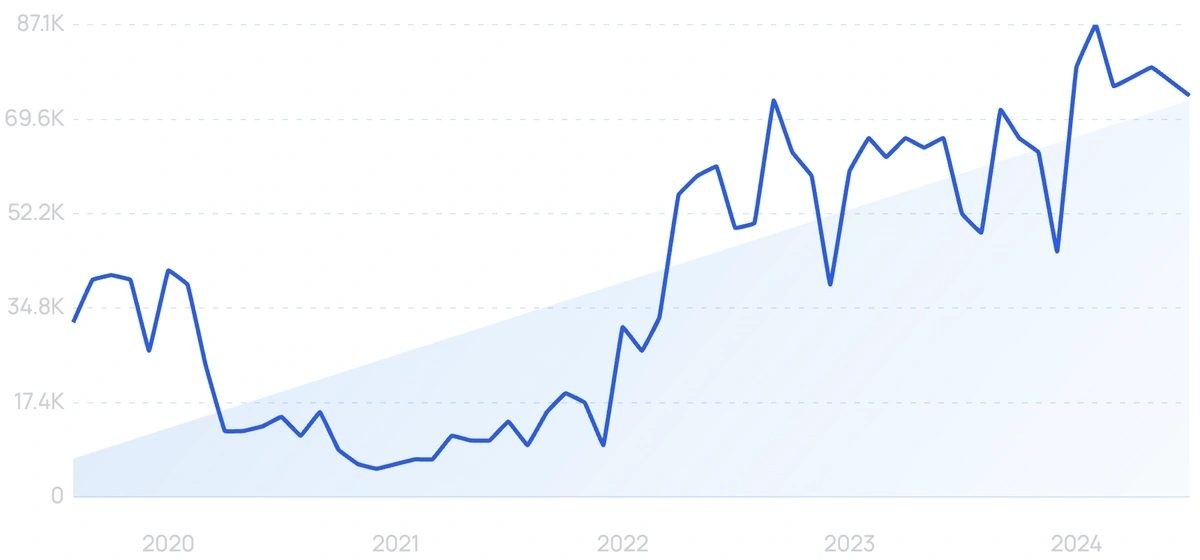Funding & Investment in Travel
18 Companies & Startups Revitalizing Travel in 2024

You may also like:
The travel industry was one of the hardest hit industries during the pandemic.
In 2023, global tourism recovered, jumping back to 84% of pre-pandemic levels. Also, global travel and tourism revenue is expected to grow from $927.3 billion in 2024 to $1.1 billion by 2028.
However, the industry as a whole isn’t expected to recover until 2027.
Despite that, some travel startups are still growing exponentially.
Check out this list of companies that are looking to revitalize the travel industry in 2024 and beyond.
1. TravelPerk
5-year search growth: 130%
Search growth status: Exploding
Year founded: 2015
Location: Barcelona, Spain
Funding: $664.1M (Debt Financing)
What they do: TravelPerk is a travel management platform designed to simplify business travel. It offers a centralized platform for booking, managing, and analyzing business travel, with features such as real-time booking, expense management, and travel policy enforcement. The company aims to reduce the time and cost associated with business travel while providing a seamless and enjoyable experience for travelers.
In 2023, revenue grew 70% and gross profit 90% year over year as annual booking volumes reached $2 billion. The company also raised an additional $104 million in January 2024 at a valuation of $1.4 billion.
2. SafetyWing

Search growth status: Exploding
Year founded: 2017
Location: Palo Alto, California
Funding: $47.1M (Series B)
What they do: SafetyWing is an insurtech company that focuses on digital nomads. Their flagship, “Nomad Insurance,” is accepted across several different countries (ideal for travel). SafetyWing also offers a B2B “Remote Health” product that provides coverage for remote teams. In 2023, SafetyWing grew revenue to $20.3 million and served over 25,000 customers.
3. Airalo

5-year search growth: 99x+
Search growth status: Exploding
Year founded: 2019
Location: Singapore, Singapore
Funding: $67.3M (Series B)
What they do: Airalo is an alternative to using multiple SIM cards while traveling. Specifically, the company offers over 190 affordable “eSIMs” that can be switched over with a few clicks. eSIMs aren’t supported by all smartphones, but they are becoming an increasingly common feature in newer models. The SIM company recently raised $60 million in its most recent series B funding round.
4. Roadsurfer

5-year search growth: 1,329%
Search growth status: Exploding
Year founded: 2017
Location: Munich, Germany
Funding: $33.9M (Series Unknown)
What they do: Roadsurfer rents customized camper vans in 13 European countries and, most recently, the United States. In addition to the core rental service, the startup offers a number of optional add-ons for each trip, like kitchen cutlery. Each plan also includes an insurance policy. Today, the company has 70 stations across Europe and North America.
5. YouLi (YouLive to Travel)

5-year search growth: 100%
Search growth status: Peaked
Year founded: 2016
Location: Melbourne, Australia
Funding: $200K (Angel)
What they do: YouLi is an all-in-one travel management software for organizing group trips and company retreats. The software includes a number templates for different types of travel itineraries. The software also has a member’s area that travelers can use to manage and pay for their trips.
6. PickYourTrail

5-year search growth: 111%
Search growth status: Exploding
Year founded: 2014
Location: Chennai, India
Funding: $3M (Series Unknown)
What they do: PickYourTrail is a platform for booking entire trips online (including flight, road transportation, and lodging). The startup reports that 46,000 people have used the service to date.
7. Tracki

5-year search growth: 143%
Search growth status: Exploding
Year founded: 2019
Location: New York, NY
Funding: Undisclosed
What they do: Tracki is a travel tech startup that provides real-time GPS tracking solutions for individuals, families, and businesses. Their products range from portable GPS trackers to asset trackers and pet trackers, which can be easily monitored through their mobile app or web platform. The app has more than 500,000 downloads on the Google Play Store.
8. Holisto

5-year search growth: 9,445%
Search growth status: Exploding
Year founded: 2015
Location: Rishon Letsiyon, Israel
Funding: $19.3M (Corporate Round)
What they do: Holisto is a digital travel agency that makes online hotel bookings more affordable and personalized for travelers. The company primarily leverages AI and machine learning to scan and aggregate hotel rates into one platform. In July 2024, the startup raised $10 million from Trivago.
9. Holafly

5-year search growth: 2,400%
Search growth status: Exploding
Year founded: 2018
Location: Madrid, Spain
Funding: $200.6K (Seed)
What they do: Holafly is an eSIM startup that offers international data plans for travelers. The company partners with local providers in different countries and offers unlimited data plans for a fixed time period. Currently, the startup operates in 160+ countries with 1 million customers worldwide.
10. Away

5-year search growth: -14%
Search growth status: Regular
Year founded: 2015
Location: New York, New York
Funding: $181M (Series D)
What they do: Away is a DTC travel brand. Often called the “Warby Parker for suitcases,” the company keeps overhead costs low by selling direct-to-consumer. Away’s product line includes travel luggage, sleep masks, travel pillows and blankets, and compression socks.
11. GOTRAX

5-year search growth: 326%
Search growth status: Exploding
Year founded: 2017
Location: Denver, Colorado
Funding: Undisclosed
What they do: GOTRAX is an electric scooter company that provides affordable and eco-friendly transportation solutions for urban dwellers. With a range of electric scooters for adults and kids, GOTRAX offers a convenient and cost-effective way to navigate through busy city streets.
12. Lodgify

5-year search growth: 197%
Search growth status: Exploding
Year founded: 2012
Location: Barcelona, Spain
Funding: $36.6M (Series B)
What they do: Lodgify develops software that helps property owners manage their vacation rental properties. The all-in-one website includes features to manage bookings, accept reservations, and synchronize across different platforms, including Airbnb, Vrbo, and Expedia.
13. Bobobox
5-year search growth: 200%
Search growth status: Regular
Year founded: 2017
Location: Badung, Indonesia
Funding: $13M (Non-Equity Assistance)
What they do: Bobobox is a technology-based hospitality startup that provides affordable and accessible capsule hotels for travelers in Indonesia. The company utilizes an app-based platform that allows customers to book and manage their stays, as well as access various hotel amenities and services.
Bobobox aims to revolutionize the hospitality industry in Indonesia by offering affordable and convenient lodging options that cater to the needs of modern travelers. The app has generated more than 1 million downloads on the Google Play Store.
14. Questo

5-year search growth: 2%
Search growth status: Peaked
Year founded: 2017
Location: Bucharest, Romania
Funding: $1.8M (Seed)
What they do: Questo is a mobile app for iPhone and Android that gamifies city exploration. Users embark on “quests” to discover interesting spots and learn about local lore. Each quest is designed by a local “creator.” The app currently offers quests in over 500 cities to more than 400,000 players.
15. Bespoke

5-year search growth: 31%
Search growth status: Exploding
Year founded: 2015
Location: Tokyo, Japan
Funding: $2.5M (Series B)
What they do: Bespoke has developed an AI-powered chatbot designed for multilingual guest services. Their software provides hotel guests with answers to hotel-specific questions, local recommendations, and restaurant reservations. Bespoke was used by the Japanese government during COVID-19 to communicate critical health and safety updates to residents and travelers.
16. Tailos (Formerly Maidbot)

5-year search growth: 131%
Search growth status: Regular
Year founded: 2015
Location: Austin, Texas
Funding: $50K (Series B)
What they do: Tailos, formerly Maidbot, manufacturers a housekeeping robot (named Rosie) designed to clean hotels and commercial buildings. Rosie takes on “dull, dirty, and dangerous tasks”, in order to reduce injuries to staff while increasing productivity and consistency.
17. TasteAtlas

5-year search growth: 833%
Search growth status: Peaked
Year founded: 2018
Location: Zagreb, Croatia
Funding: Undisclosed
What they do: TasteAtlas is a food and travel startup that provides a comprehensive guide to traditional dishes, drinks, and ingredients from all over the world. The platform offers a database of authentic food recommendations and local restaurants to help travelers discover new cuisines and experiences. Additionally, TasteAtlas allows users to create their own food maps and share their culinary discoveries with others.
18. Roame Travel

5-year search growth: 7,200%
Search growth status: Exploding
Year founded: 2023
Location: San Francisco, California
Funding: $500K (Pre-Seed)
What they do: Roame is a free award travel search engine that finds available flights that qualify for credit card points and miles redemption. Currently, Roame provides search results for 16 airline loyalty programs and 200 airlines. Users can upgrade to a premium membership to access the SkyView feature, a search function that finds flights within a 90-day search window.
Conclusion
That wraps up our list of travel startups growing despite the hardships of the pandemic.
The trend away from traditional hotels and towards short-term rental properties, RVs, and campsites accelerated this year as more people work remotely and seek a change of scenery.
There is also a notable shift towards AI and automation, as hotels seek to cut costs and increase efficiency.
Funding & Investment in Travel
Startups Supplying Scarce Materials And Rare Earth Elements See Abundant VC Funding

It’s well known that scaling cutting-edge technologies and battery production requires supply-constrained materials such as lithium, cobalt and nickel, as well as rare earth elements sourced from just a few locations on the planet.
Tech giants, automakers and other industrial players have long been cognizant of the supply chain risks. And recent headlines show concerns increasingly spilling over into geopolitics.
Startups haven’t been sitting this one out either. In the past few quarters, a growing roster of venture-backed companies has secured funding for areas including battery and magnet recycling, rare earth-focused mining technology, and even extracting materials from space.
Collectively, they’ve raised billions to date, including some large recent rounds. To illustrate, we used Crunchbase data to put together a list of a dozen companies, most funded in the past year, with a mission of supplying scarce materials through recycling or at their original source.
Most venture money going to recycling
The largest investment recipients are focused on recycling, looking to extract scarce materials from devices, scrap, batteries and industrial machines no longer in use.
In this arena, the two most heavily funded startups — Massachusetts-based Ascend Elements and Nevada-based Redwood Materials — are both focused on batteries and have been around a while. Together, they’ve pulled in nearly $3 billion in equity funding and over $1 billion in debt financing to date.
Notably, however, both companies secured most of their funding between 2021 and 2023. That coincided with a more bullish period overall for cleantech equity funding. Since then, sustainability-focused investment has trended lower, with U.S. investors in particular seeing impacts from the Trump administration dialing back support for clean energy initiatives.
Outside the U.S., meanwhile, we’ve seen some more recent, sizable rounds around critical materials recycling.
Out of Canada, Cyclic Materials announced in June that it raised $25 million to build a rare earth recycling facility in Kingston, Ontario. It will take magnet-rich scrap and retired industrial products to recycle rare earth elements used in EV motors, wind turbines and consumer devices. Per Cyclic, it’s an undertapped market, as today, less than 1% of rare earth elements are recycled.
On the earlier-stage side, two German companies also raised good-sized financings. Cylib, which develops technology to draw critical raw materials from end-of-life batteries, picked up a $64 million Series A last spring. And at seed-stage, Munich-based Tozero secured $12 million for a plant to recover raw materials from recycled lithium-ion batteries.
Mining attracts capital too, following MP Material’s footsteps
Startup capital is also flowing to ventures focused on mining critical materials.
Before looking at the latest funding picks, however, it seems worth pointing out that MP Materials — the company generating headlines of late around rare earth mining — is itself a stock market success story with some Silicon Valley roots.
Shares of Las Vegas-based MP shot higher this month following news that the U.S. Defense Department agreed to buy an equity stake in the company, which operates the country’s only rare earth mine in Mountain Pass, California. A few days later, Apple announced a $500 million commitment to buy rare earth magnets developed at an MP Materials’ facility in Fort Worth, Texas.
Notably, MP was one of the earlier companies to ride the SPAC boom, making its public market debut in 2020 through a merger with a blank-check company. The deal included an equity investment from backers including venture capitalist and onetime “SPAC king” Chamath Palihapitiya.
More recently, we’ve seen a few startups nab venture and debt financing around mining efforts and technologies targeting scarce metals.
Montreal-based Torngat Metals secured $120 million in debt financing last month from government sources for a rare earth mining project in Strange Lake, located in Quebec’s northernmost region. It touts the project, which includes “detailed caribou avoidance procedures,” as a strategically important national initiative in a time when Chinese domination of heavy rare earth metals threatens others’ ability to build and source high-performance magnets.
Phoenix Tailings, based in Woburn, Massachusetts, also attracted investors’ interest, pulling in $76.4 million in fresh financing this year, per a May securities filing. The company has developed a process to extract valuable metals and rare earth elements from mining waste.
Exits next?
Major U.S. market indices are trading near all-time highs these days, so it’s looking like a good time for public companies in a lot of industries. But those tied to sourcing of rare metals and battery materials are riding particularly high.
MP Materials, for instance, had a recent market cap around $10 billion — its highest to date. Rare earth stocks more broadly are also sharing in the enthusiasm.
Could IPOs and acquisitions for the most heavily funded companies tied to sourcing scarce materials be next? These aren’t likely to be the fastest-moving spaces for dealmaking, but at least for now some momentum is on their side.
Related Crunchbase query:
Related reading:
Illustration: Dom Guzman
Stay up to date with recent funding rounds, acquisitions, and more with the
Crunchbase Daily.
Funding & Investment in Travel
The Wrong Way To Think About Implementing AI Agents

By Sagi Eliyahu
Recently, analysts at Gartner published a bold prediction regarding the future of agentic AI in the enterprise: more than 40% of in-progress agentic AI projects will be canceled by the end of 2027.
This would seem to support other recent findings from related studies on AI agents in the enterprise. Earlier this year, for example, researchers at Carnegie Mellon University conducted an interesting-yet-flawed experiment: They staffed a fake software company, TheAgentCompany, entirely with AI agents. They asked the agents — each powered by a specific LLM — to take on the day-to-day work of a modern software company. They assigned the agents work, and that was about it so far as instruction or orchestration. After that, they asked them to get to work.
AI agents have been the subject of frenzied excitement in the enterprise, with such prominent CEOs as Mark Benioff, Jensen Huang, Satya Nadella and Mark Zuckerberg all predicting their impending, transformative preeminence.
CMU’s experiment, therefore, garnered lots of interest. But as outlets like Business Insider have reported, the results were not good. The best-performing agent finished just 24% of the jobs assigned to it. Most completed just 10%. It cost each agent on average $6 to complete an individual task, which added up quickly, since the jobs the agents had been assigned required completing many different tasks. Simple tasks stalled due to agents’ inability to overcome unexpected challenges, like dismissing a pop-up ad.
Observers were quick to interpret these results — along with results of still more studies conducted over the past year or so — as evidence that AI agents are perhaps not quite as capable as tech CEOs have made them out to be.
“[AI agents] are clearly not ready for more complex gigs humans excel at,” Futurism’s Joe Wilkins wrote.
Here’s how Business Insider’s Shubham Agarwal put it: “The findings, along with other emerging research about AI agents, complicate the idea that an AI agent workforce is just around the corner — there’s a lot of work they simply aren’t good at.”
Agarwal concluded the experiment was a “total disaster.”
This, however, is the incorrect conclusion to draw — incomplete at best and irrelevant at its core.
Augment, don’t replace
That’s because it stems from a flawed premise — specifically, that AI agents should be expected to replace humans outright. They’re not. They’re meant to augment them.
The agents in CMU’s experiment, in other words, were set up to fail. The culprit in the experiment was not the capacity of the agents themselves, but a misapplication of their purpose.
This, interestingly, is what underpins Gartner’s recent research into AI agents in the enterprise. According to Anushree Verma, a senior director analyst at Gartner, many in-progress AI agent deployments will fail ultimately because, “They are mostly driven by hype and are often misapplied.”
What CMU’s experiment ultimately showcases is precisely this: what happens when agentic AI rollouts stem foremost from such misapplication. It proves not that agents can’t complete complex work, but rather that CMU simply attempted to implement AI agents in entirely the wrong way.
So what’s a better way? To start, we shouldn’t treat this technology as magic.
AI agents, simply put, are tools. They’re not human replacements. They’re things for humans to use.
And just like any tool, the value humans derive from agents comes down not just to how smart or powerful individual agents are, but how strategically we leverage them to improve our own capacity.
Setting a bunch of specialized AI agents loose inside an organization without structures governing how they should work with each other or with human workers — not to mention without connecting them to the various departments, systems and policy centers, such that they can be orchestrated across them — simply isn’t very strategic.
In fact, it’s not a strategic way to leverage any tool, resource or intelligent entity, humans included. Try the same experiment, but substitute AI agents with highly intelligent human workers. Let those workers loose inside your organization without roles, responsibilities, organization or protocol, and you’ll get the same result: noisy, inefficient, expensive chaos.
LLMs can’t deliver consistently good work or work effectively together toward a common set of goals without other supporting technology or infrastructure.
So what might be more useful instead? If the goal is to determine what, ultimately, AI agents are capable of in an enterprise context, we should experiment with them using conditions consistent with an enterprise context. And we should ensure there’s adequate structure in place behind the scenes — such as end-to-end orchestration infrastructure — enabling AI agents to deliver genuine enterprise value.
Structure and strategy matter
People who believe AI agents are exciting because they’ll replace humans have it all wrong. AI agents are exciting not because they’ll replace humans, but because they’ll replace traditional enterprise software.
It’s in this way that AI agents could transform the enterprise — by improving not just the capacity of human-led organizations, but the experiences provided human workers inside them.
But only if we will it. For organizations of every sort — from TheAgentCompany to Alphabet to those surveyed by Gartner — getting transformational value out of agents will come down to one thing: how strategically we integrate them into the infrastructure of our day-to-day operations, and what sort of structures we put in place to govern them.
This is as true of AI agents as it is of any other sort of intelligent entity we leverage inside the enterprise, including humans. Intelligent entities need structure to work effectively. You want intelligent entities to be able to work autonomously and creatively in pursuit of the goals you set for them. But to effectively pursue those goals, you also need direction and hierarchy, governance and org charts, processes and rules.
It’s on what sort of structure we put around AI agents, in order to maximize their impact for humans, that we should be iterating and experimenting.
This is a matter, in the end, not only of strategy and performance, but of security; thinking carefully about how we construct and deploy AI agents in the enterprise, for example, is how we will wall off AI from things it shouldn’t be touching internally, such as login credentials, sensitive data or certain actions.
It’s also, however, the only way we’ll ever truly find out just what this technology is capable of. Anything else is a waste of time.
Sagi Eliyahu is the co-founder and CEO of Tonkean, an AI-powered intake and orchestration platform that helps enterprise-shared service teams such as procurement, legal, IT and HR create processes that people actually follow. Tonkean’s agents use AI to anticipate employees’ needs and guide them through their requests.
Related reading:

Stay up to date with recent funding rounds, acquisitions, and more with the
Crunchbase Daily.
Funding & Investment in Travel
New travel fees for Brits heading to Mallorca

British travellers will soon need to fork out 7€ for an ETIAS permit to visit popular holiday destinations like Spain though the system’s implementation has been pushed back to 2027. The fee will only apply to tourists aged between 18 and 70, whilst younger and older visitors won’t face any charges.
-

 Brand Stories1 day ago
Brand Stories1 day agoBloom Hotels: A Modern Vision of Hospitality Redefining Travel
-

 Brand Stories7 hours ago
Brand Stories7 hours agoOlive Living: India’s Intelligent, Community-Centric Hospitality Powerhouse
-

 Destinations & Things To Do2 days ago
Destinations & Things To Do2 days agoUntouched Destinations: Stunning Hidden Gems You Must Visit
-

 AI in Travel2 days ago
AI in Travel2 days agoAI Travel Revolution: Must-Have Guide to the Best Experience
-

 Brand Stories3 weeks ago
Brand Stories3 weeks agoVoice AI Startup ElevenLabs Plans to Add Hubs Around the World
-

 Brand Stories2 weeks ago
Brand Stories2 weeks agoHow Elon Musk’s rogue Grok chatbot became a cautionary AI tale
-

 Asia Travel Pulse2 weeks ago
Asia Travel Pulse2 weeks agoLooking For Adventure In Asia? Here Are 7 Epic Destinations You Need To Experience At Least Once – Zee News
-

 AI in Travel2 weeks ago
AI in Travel2 weeks ago‘Will AI take my job?’ A trip to a Beijing fortune-telling bar to see what lies ahead | China
-

 Brand Stories2 weeks ago
Brand Stories2 weeks agoChatGPT — the last of the great romantics
-

 Brand Stories2 weeks ago
Brand Stories2 weeks agoHumans must remain at the heart of the AI story

